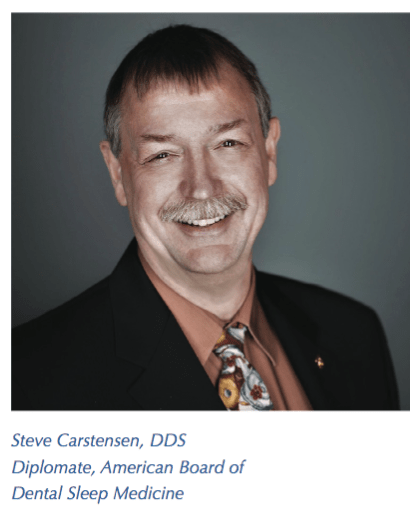by Steve Carstensen, DDS, Diplomate, American Board of Dental Sleep Medicine
 Long have the pages of Dental Sleep Practice been devoted to helping the individual dentist navigate the uncertain path between traditional dentistry and specialized medical care. Between these two provider groups lie primary care, in all its forms and with various labels affixed to its practitioners such as family practice, advanced registered nurse practitioners, and various specialized medical providers not devoted strictly to sleep medicine. Leaders in medicine have called out the current state of health care where tens of millions of people lack diagnosis, let alone treatment or management, of serious airway-related disease. Trade groups associated with their particular constituents have mostly stuck with their mandate: look out for their own when it comes to defining practice while in more public pronouncements appearing to be interested in addressing the health care crisis of those tens of millions and their impact on the health care system, quality of life, and spending patterns in the community.
Long have the pages of Dental Sleep Practice been devoted to helping the individual dentist navigate the uncertain path between traditional dentistry and specialized medical care. Between these two provider groups lie primary care, in all its forms and with various labels affixed to its practitioners such as family practice, advanced registered nurse practitioners, and various specialized medical providers not devoted strictly to sleep medicine. Leaders in medicine have called out the current state of health care where tens of millions of people lack diagnosis, let alone treatment or management, of serious airway-related disease. Trade groups associated with their particular constituents have mostly stuck with their mandate: look out for their own when it comes to defining practice while in more public pronouncements appearing to be interested in addressing the health care crisis of those tens of millions and their impact on the health care system, quality of life, and spending patterns in the community.
The optimist in me notices the steps some organizations are taking to reach out to find novel solutions, address the crisis in new ways, bring more trained providers into the system. The inclusion of a committed, passionate, and sufficiently trained professional to the treatment team makes everyone more ‘productive,’ meaning able to impact more of the community via proper identification, diagnosis and treatment. What is happening in an increasingly common way is highly trained specialists accepting that they cannot see everyone with minor manifestations of ‘their’ disease – the sickest patients belong in their office with the less afflicted being seen by trusted professionals lacking their specific credentials.
This is a two-way street. Any medical provider who wishes to be part of this team must commit to earning their way to the table. Proper education and demonstration of understanding the skills required is mandatory and should be supervised from the highest levels. Those occupying the lofty reaches of specialized knowledge must, in turn, reach out and provide opportunities for those non-specialists professionals to become valuable adjuncts to the main effort, reducing the number of undiagnosed symptomatic people in our community.
People are interested in better sleep. Editors of consumer publications choose stories based on what their audience wants – and it’s easy to notice many sleep-related themes online, in print, and on popular television. Gadgets to inform the wearer of sleep quality and snoring, address insomnia, and promote better sleep position are found in every electronic store and online retail outlet. It’s not difficult for anyone to order a boil-and-bite oral appliance, nasal breathing aid, positive air pressure system or even a custom mandibular advancement device, all without any professional oversight.
Professionals who remain siloed and turf-protective are going to stay busy, economically well-compensated, and reinforced by like-minded members of their group. Increasingly, however, they will become irrelevant as innovative ways of providing health care are demanded by consumers and less qualified professionals. Opening the way for increased participation by training other providers to do what they can to help is the way for all of us to meet consumer demand in a safe and medically sound manner. That is the path for better community health.
Dr. Michael Simmons discussed the importance of proper training in dental sleep medicine to continue impacting the dental community in his article here.